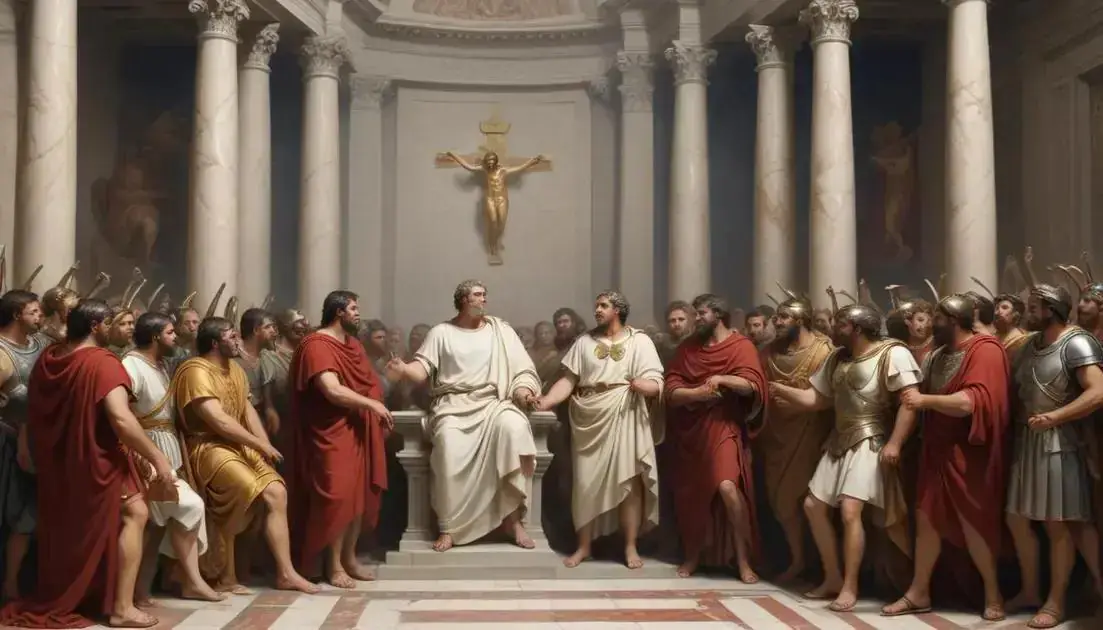
Edict of Milan: Legalization of Christianity in the Roman Empire
The Edict of Milan, established in 313 AD by Emperors Constantine and Licinius, legalized Christianity in the Roman Empire, ending years of persecution. This decree transformed Christian communities, fostering significant cultural shifts such as the rise of Christian art and literature, and encouraging public celebrations of Christian holidays. The long-term effects reshaped laws, societal norms, and contributed to Christianity’s prominence in Western civilization, marking a pivotal moment in history for religious tolerance and communal growth.
The Edict of Milan is a pivotal moment in history, marking a significant shift towards religious freedom in the Roman Empire. Are you curious about how this decree changed the lives of Christians back in 313 AD?
Historical context of the Edict of Milan
The Edict of Milan was announced in 313 AD. This decree was very important for Christianity. Before this, Christians faced serious persecution and even death. They could not practice their faith openly. Many hid their beliefs in fear.
The backdrop was the Roman Empire. During this time, it was common for people to worship many gods. However, Christianity was growing rapidly. More people were turning to this religion, which alarmed some leaders.
Two key figures behind the Edict were Emperor Constantine and Emperor Licinius. Constantine believed in religious freedom and saw that it benefited the empire. Licinius, an ally of Constantine, also agreed to the decree.
The Edict allowed Christians to worship freely. It also returned land and property that had been taken from them. This was a huge step forward for the Christian community. It changed the dynamic between the church and the state.
After the Edict, churches began to be built openly. Christians could gather without fear of arrest. This new freedom allowed them to spread their beliefs faster than ever.
In this way, the Edict of Milan marked a turning point in history. It laid the foundation for Christianity to thrive within the Roman Empire.
Key figures: Constantine and Licinius
Two main figures in the story of the Edict of Milan are Constantine and Licinius. Their leadership played a big role in shaping the future of Christianity.
Constantine was the first Roman emperor to support Christianity openly. He believed in faith and saw its potential to unify the empire. In 312 AD, he had a vision before a big battle. He claimed to see a cross in the sky, which gave him confidence and victory. This event changed his view on Christians.
After becoming emperor, Constantine wanted peace in the empire. He realized that tolerating Christianity could help calm tensions. He was also keen on bringing people together under a common belief.
Licinius, on the other hand, was an associate of Constantine. He ruled the Eastern part of the empire. They initially worked together to support Christians. But things changed over time. Licinius had different ideas about religious practices and power.
In 313 AD, both leaders signed a document called the Edict of Milan. It declared that all religions, including Christianity, could be practiced freely. This was a huge deal in the Roman world.
However, their partnership did not last. Licinius later pursued a more aggressive stance against Christians, which led to conflict with Constantine. Eventually, Constantine defeated Licinius, further solidifying his rule and support for Christianity.
These two emperors played key roles in the growth of Christianity. Their actions helped shape how the religion would grow within the Roman Empire.
Impact on Christian communities
The Edict of Milan had a huge impact on Christian communities all over the Roman Empire. Before the edict, many Christians faced the threat of persecution. They couldn’t practice their faith freely, which made life very difficult.
Once the edict was signed in 313 AD, everything changed. Christians were now allowed to worship openly. This freedom gave them hope and strength. They could gather in groups and build churches without fear of punishment.
Many Christians took this chance to grow their communities. They started to organize more events, celebrate their beliefs, and bring in new followers. Churches began to spring up, and the faith spread quickly.
The change also helped Christians feel more united. With common goals and freedom, they formed strong bonds. They focused on spreading the message of hope and love in their communities.
This new openness also attracted the attention of people who weren’t Christians. Many were curious about this faith that was suddenly thriving. Conversions increased as people learned more.
However, the impact wasn’t all positive. Some groups opposed the growth of Christianity. This led to tensions and sometimes conflicts between those who embraced the Christian faith and those who didn’t. Yet, despite challenges, the resilience of Christians shone through. They continued to build their communities in the face of adversity.
Overall, the Edict of Milan marked a turning point. Christian communities transformed from persecuted groups into thriving, vibrant factions, playing a significant role in society.
Long-term effects on the Roman Empire
The Edict of Milan had long-lasting effects on the Roman Empire. It marked a shift in how religion was viewed in society. Before the edict, Christians were often persecuted. They had to hide their beliefs. But after the edict, Christianity became a legitimate faith.
This change encouraged many to convert to Christianity. Over time, it transformed from a small group to a major religion. The growing Christian population influenced many aspects of Roman life.
One major impact was the way laws were made. With more Christians in power, laws began to reflect Christian values. This led to a society that prioritized compassion, charity, and morality.
Additionally, as support for Christianity grew, the Roman Empire saw a rise in church influence. Churches became important places not just for worship, but also for community support. They provided help to the needy and played a role in education.
The edict also changed relationships with non-Christian groups. While many embraced the new faith, others resisted it. This sometimes led to conflicts or tensions between different religious groups.
Moreover, the Edict of Milan set a precedent for religious tolerance. It introduced the idea that beliefs should be respected. This notion would influence future empires and nations in their dealings with religion.
Overall, the long-term effects of the Edict of Milan reshaped the Roman Empire. It moved it towards a more inclusive society. It laid the groundwork for Christianity’s rise as a central part of Western culture.
Cultural shifts post-edict
The Edict of Milan led to significant cultural shifts in the Roman Empire. With the legalization of Christianity, many traditions began to change. People started to see Christianity as an important part of their lives. This new faith influenced art, literature, and daily practices.
One major change was in how art was created. Artists began to focus on Christian themes. They painted scenes from the Bible and created images of saints. This helped spread the Christian message visually. Churches became filled with beautiful artwork that told stories from the faith.
Cultural festivals also evolved. Before the edict, many Roman holidays celebrated pagan gods. Afterward, Christian holidays began to take prominence. People celebrated Christmas and Easter, marking important events in the Christian calendar.
Writings also shifted. Writers started to document Christian teachings and history. Books and letters about faith became more common. This growth in Christian literature helped educate the public about their new beliefs.
Another important change was in community life. Church gatherings became social events. People came together for worship, support, and fellowship. This strengthened community bonds among believers.
Even language began to reflect this cultural shift. New terms and phrases entered common use. Words related to faith became part of everyday conversations. This made discussing beliefs easier for everyone.
Overall, the Edict of Milan not only changed laws but also reshaped the very culture of the Roman Empire. It set the stage for Christianity to have a lasting impact on Western civilization.
Conclusion
In conclusion, the Edict of Milan profoundly changed the course of history for Christianity and the Roman Empire. By granting religious freedom, it allowed Christians to practice their faith openly. This shift not only helped Christianity grow but also influenced the culture, art, and daily lives of people.
The long-term effects of the edict can still be seen today. It paved the way for Christianity to become a major part of Western civilization. The cultural shifts following the edict showed how faith could influence everything from holidays to community gatherings.
Overall, the Edict of Milan represents a crucial moment in history. It reminds us how important it is to respect different beliefs and the power they have to unite people.


